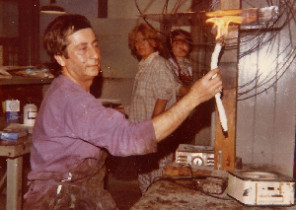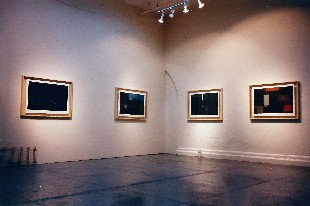Pretoria, Johannesburg
 Born 1935 of British parents in Pretoria South Africa, Elizabeth Harington has committed most of herself to art, music and etching. Her formal education began under Charles Argent at the University of the Witwatersrand in Johannesburg, South Africa.
Born 1935 of British parents in Pretoria South Africa, Elizabeth Harington has committed most of herself to art, music and etching. Her formal education began under Charles Argent at the University of the Witwatersrand in Johannesburg, South Africa.
During the course of this early education, young Harington was honored as the most talented university Art student and awarded a commission to create a frieze for the South African Arts Festival in 1956.
This full featured frieze may have been the beginning of her career but for the political climate this early creativity was censored by the State. The 100”X 6” feet fresco completed after 3 months exposed the struggle and constraint of tortured figures against a twisted rope spanning the entrance to the Great Hall. Before the festival opened, the frieze was torn down from its place of honor. This dashed opportunity for national recognition became a personal disillusionment. This masterpiece has now passed into the vestiges of time.
New York
 In 1978, Harington arrived in New York for a two year residency at the Art Students League under the tutelage of renown Roberto Delamonica.
In 1978, Harington arrived in New York for a two year residency at the Art Students League under the tutelage of renown Roberto Delamonica.
Here she produced a series of prints based on anatomical studies. These graphic representations sometimes of skin peeled back had a spiritual component: they involved the journey within like the peeling of an onion to complete nakedness and internal revelation. This project evolved under the influence of Victorian Indian poet, Rabindranath Tagore who as a musician and artist expressed the message of the heart as a collusion of music, art and poetry formed from the depths of our spirit. His poetic representations honor silence and express empty sound as the artistic parallel of empty space.
 Delmonica then saying “take an etching press back to South Africa” she returned to South Africa with a Charles Brand Etching Press where she taught and printed out of her garage until 1986, returning to the Art Students League on a student F-1 Visa. Working by day in the cafetaria and printing at night, she drew more away from the flesh of Tagore to the symmetrical counterpoints of Bach.
Delmonica then saying “take an etching press back to South Africa” she returned to South Africa with a Charles Brand Etching Press where she taught and printed out of her garage until 1986, returning to the Art Students League on a student F-1 Visa. Working by day in the cafetaria and printing at night, she drew more away from the flesh of Tagore to the symmetrical counterpoints of Bach.
The first artistic expression of Bach was through the study of The Well Tempered Clavier.
In 1997 Elizabeth Harington was awarded Permanent Residency for exceptional ability in the arts after 10 years of seeking a green card.
Bach
 Harington’s impassioned interest in classical piano while involved in the artistic interpretation of Tagore drove an ambition to explore J.S. Bach and his association with printmaking. Bach is that printmaker. Sharing this understanding with Bach, Harington became intent to discover the depths and stimulus for Bach’s musical and creative genius. Harington’s first project to unwrap the artistic musical inspiration behind Bach involved the study of Bach’s Preludes and Fugues. These composures were much premised on a scalar and circular orientation, much like a shell and alternated between major and minor beginning with focal point C major and culminating in B minor. Harington manifested these tonal expressions as mostly spiral in representation.
Harington’s impassioned interest in classical piano while involved in the artistic interpretation of Tagore drove an ambition to explore J.S. Bach and his association with printmaking. Bach is that printmaker. Sharing this understanding with Bach, Harington became intent to discover the depths and stimulus for Bach’s musical and creative genius. Harington’s first project to unwrap the artistic musical inspiration behind Bach involved the study of Bach’s Preludes and Fugues. These composures were much premised on a scalar and circular orientation, much like a shell and alternated between major and minor beginning with focal point C major and culminating in B minor. Harington manifested these tonal expressions as mostly spiral in representation.
 The Preludes and Fugues portfolio features 24 etchings, (BWV 858-869), that are as varied and different as the elements that make up the superbly integrated musical pieces they accompany. This progression of understanding was sponsored by numerous fellowships and grants including a MacDowell Colony Fellowship in 1990, the Pollack Krasner Award of 1991 and the Gottlieb Foundation Award of 1992. Though Harington provided for a systematic graphic representation of these musical pieces, Harington began to see herself developing Bach on a more three dimensional symmetrical space.
The Preludes and Fugues portfolio features 24 etchings, (BWV 858-869), that are as varied and different as the elements that make up the superbly integrated musical pieces they accompany. This progression of understanding was sponsored by numerous fellowships and grants including a MacDowell Colony Fellowship in 1990, the Pollack Krasner Award of 1991 and the Gottlieb Foundation Award of 1992. Though Harington provided for a systematic graphic representation of these musical pieces, Harington began to see herself developing Bach on a more three dimensional symmetrical space.
To provide this greater dimension to Bach’s music, Harington then endeavored to represent Bach’s work as folded prints represented in book form. For this project Harington examined Bach’s Art of Fugue and clearly saw the symmetrical nature of these musical pieces. The Art of Fugue revolves around a counter point much like a folded page around its fold. This project was released to the Colophon Pages – Modern Illustrated and Fine Press Books for consignment. This project was sponsored primarily by the Pollock Krasner Award of 1995 and the Gottlieb Foundation Award of 1996 and exhibited at the Art Students League in 2006. The project consists of three books of 8 folded prints each. A proposed study will be the mathematical animation of this piece.
Harington then reverted back to two dimension with an analysis of the Two and Three Part Inventions – the “Mirror Fugues”. It was during this next intimacy with Bach’s work that Harington fell upon her most important revelation.
 Harington’s artistic analysis continued to return to the understanding that Bach’s music revolved around a single mirrored point. This quality of musical reflection is most pronounced in the Two and Three Part Inventions. During this study Harington was struck with the revelation that as Bach had printed his scores he must have developed an intuitive sense of the mirror image: As a printmaker Bach would have had to print his scores as reflections of their original thought. The etching plates would have been reversed from their final image. This intimate conceptual understanding has made her a recognized subject matter expert of both Bach and art. Harington was afforded an opportunity to then speak with Davitt Maroney, Professor of Music at the University of California about projecting a completion to the Art of Fugue, which was left unfinished by Bach on his deathbed. This project earned Harington awards from the Pollack Krasner in 2002 and 2008. In 2011 Harington was awarded the Lee Krasner Lifetime Achievement Award for her contributions.
Harington’s artistic analysis continued to return to the understanding that Bach’s music revolved around a single mirrored point. This quality of musical reflection is most pronounced in the Two and Three Part Inventions. During this study Harington was struck with the revelation that as Bach had printed his scores he must have developed an intuitive sense of the mirror image: As a printmaker Bach would have had to print his scores as reflections of their original thought. The etching plates would have been reversed from their final image. This intimate conceptual understanding has made her a recognized subject matter expert of both Bach and art. Harington was afforded an opportunity to then speak with Davitt Maroney, Professor of Music at the University of California about projecting a completion to the Art of Fugue, which was left unfinished by Bach on his deathbed. This project earned Harington awards from the Pollack Krasner in 2002 and 2008. In 2011 Harington was awarded the Lee Krasner Lifetime Achievement Award for her contributions.
Robert Blackburn Printmaking Workshop
 Recently associated with the late and great Bob Blackburn at the previous Robert Blackburn Printmaking Workshop.
Recently associated with the late and great Bob Blackburn at the previous Robert Blackburn Printmaking Workshop.
Will Barnett became associated with Elizabeth Harington at the Printmaking Workshop and found her work extraordinary. He demonstrated an interest in these musical representations. On his passing he bequeathed Harington a scholarship to continue her studies at the Art Students League. Harington continues her artistic developments recently with a set of mixed media representations of the enneagram in circular form.
John Cage also expressed an interest in a possible collaboration if not for his subsequent passing.
Vedanta
Eastern mysticism has always been of appeal to Harington but not until she was settled in New York City was she able to study these ideas in a greater depth.
Harington is an initiate in the teachings of Vedanta as enunciated by Sri Ramakrisha. These beliefs incorporate the inter connectivity of all energies and the existence of God in all.
